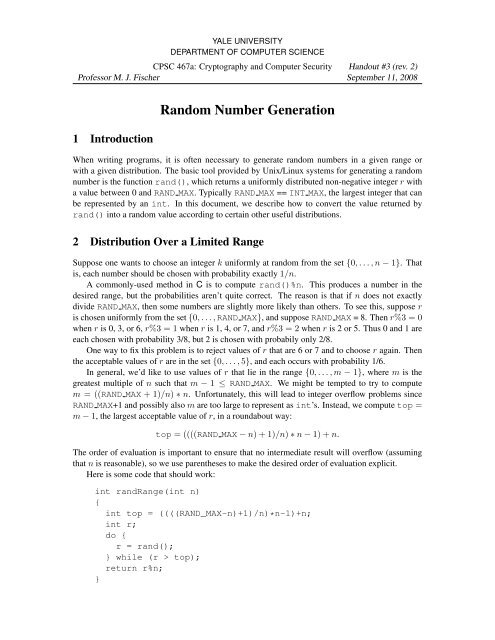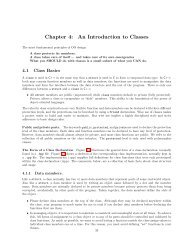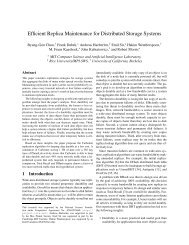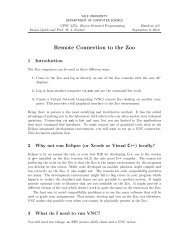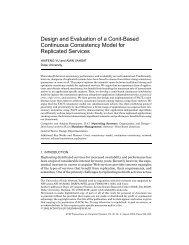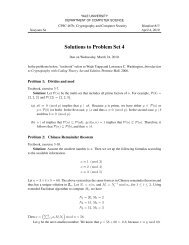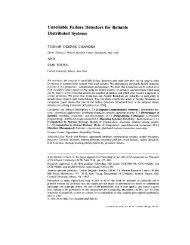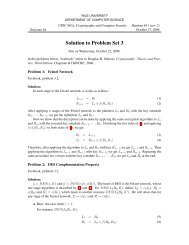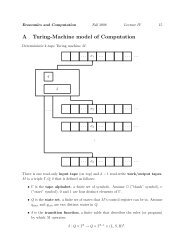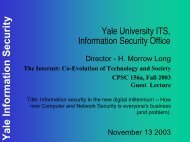Random Number Generation - Zoo - Yale University
Random Number Generation - Zoo - Yale University
Random Number Generation - Zoo - Yale University
You also want an ePaper? Increase the reach of your titles
YUMPU automatically turns print PDFs into web optimized ePapers that Google loves.
YALE UNIVERSITYDEPARTMENT OF COMPUTER SCIENCECPSC 467a: Cryptography and Computer Security Handout #3 (rev. 2)Professor M. J. Fischer September 11, 20081 Introduction<strong>Random</strong> <strong>Number</strong> <strong>Generation</strong>When writing programs, it is often necessary to generate random numbers in a given range orwith a given distribution. The basic tool provided by Unix/Linux systems for generating a randomnumber is the function rand(), which returns a uniformly distributed non-negative integer r witha value between 0 and RAND MAX. Typically RAND MAX == INT MAX, the largest integer that canbe represented by an int. In this document, we describe how to convert the value returned byrand() into a random value according to certain other useful distributions.2 Distribution Over a Limited RangeSuppose one wants to choose an integer k uniformly at random from the set {0, . . . , n − 1}. Thatis, each number should be chosen with probability exactly 1/n.A commonly-used method in C is to compute rand()%n. This produces a number in thedesired range, but the probabilities aren’t quite correct. The reason is that if n does not exactlydivide RAND MAX, then some numbers are slightly more likely than others. To see this, suppose ris chosen uniformly from the set {0, . . . , RAND MAX}, and suppose RAND MAX = 8. Then r%3 = 0when r is 0, 3, or 6, r%3 = 1 when r is 1, 4, or 7, and r%3 = 2 when r is 2 or 5. Thus 0 and 1 areeach chosen with probability 3/8, but 2 is chosen with probabily only 2/8.One way to fix this problem is to reject values of r that are 6 or 7 and to choose r again. Thenthe acceptable values of r are in the set {0, . . . , 5}, and each occurs with probability 1/6.In general, we’d like to use values of r that lie in the range {0, . . . , m − 1}, where m is thegreatest multiple of n such that m − 1 ≤ RAND MAX. We might be tempted to try to computem = ((RAND MAX + 1)/n) ∗ n. Unfortunately, this will lead to integer overflow problems sinceRAND MAX+1 and possibly also m are too large to represent as int’s. Instead, we compute top =m − 1, the largest acceptable value of r, in a roundabout way:top = ((((RAND MAX − n) + 1)/n) ∗ n − 1) + n.The order of evaluation is important to ensure that no intermediate result will overflow (assumingthat n is reasonable), so we use parentheses to make the desired order of evaluation explicit.Here is some code that should work:int randRange(int n){int top = ((((RAND_MAX-n)+1)/n)*n-1)+n;int r;do {r = rand();} while (r > top);return r%n;}
2 <strong>Random</strong> <strong>Number</strong> <strong>Generation</strong>3 Choosing a Point from the Unit IntervalNow we look at the problem of choosing a point x uniformly at random from the unit semiopeninterval [0, 1). Here, x will be of type double, so we need to convert the integer returnedby rand() to a double and scale to the correct range. Again, the naïve formularand()/(RAND MAX+1) fails because of integer overflow problems, but here the fix is simpler:just compute rand()/(RAND MAX+1.0). The addition of the double constant 1.0 will causeRAND MAX to be converted to a double before performing the addition, and the value RAND MAX+1is exactly representable as a double. Of course, this doesn’t really give the uniform distributionsince most of the real numbers in [0, 1) can never be chosen, but it is a good enough approximationfor most applications.4 Choosing an Element from an Arbitrary Finite DistributionLet U = {0, . . . , n − 1} and let P : U → [0, 1] be a finite probability distribution, that is,∑ n−1k=0P (k) = 1. We consider the problem of choosing an integer k from U according to thedistribution P . Note that this is a generalization of the problem in section 2, but here we are willingto accept a small error in the derived probabilities.The method here is to divide up the unit interval into n non-overlapping segments, where thelength of segment j is P (j). Then we generate a random real x in the unit interval using the methodof section 3, find the index k of the segment that contains x, and return k. We leave the coding ofthis method to the reader.


